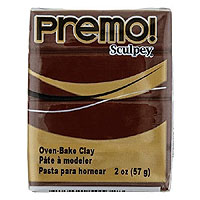I do use primarily Premo. There are several reasons for that. Well, scratch that. There is only one reason for that: it's available and it's the cheapest.
So Premo for me is like the workshorse. When I experiment on new
techniques, when I experiment on gemstone imitation, I always use Premo. For the simple reason that I can't afford to waste double the money on Fimo, or worse, on Pardo, that is already so hard to come by, even if cheaper than Fimo. Kato... just read my notes on Kato.
So, after years and years of working with Premo, what can I say about it?
Pros:
of course, availability and pricing. Here in the US it's the no. 1 on those two.
It is, really, not that bad. Easy to condition, easy to work with, has a lot of available colors, mixes quite well, good for skinner blends, mica shifts, you name it.
Talking mica shifts – the pearlescents and metallics in the Accents line, except for a couple of them, really have rich mica particle content so you can get flashy mica shift effects.
It is fairly resilient – if properly conditioned and baked, it's hardy, flexible, and all that. I had made my Bird of Paradise necklace with Premo, and the petals are about ½ mm thin, but they're flexible and very strong.
Buffs to a beautiful glossy shine
Reacts really good to surface effects and treatments, and can take water and alcohol inks as well as paints with no problem
Cons:
It can get soft and stretchy very fast when making canes. True, probably not as fast as Cernit or lately, Souffle, but still.
There is quite a bit of inconsistency and bloopers with the brand. Even if the manufacturer never admits it, even when you send them hard video evidence. I had regular translucent looking whiter than the white translucent and also horribly hard – I used TWO bottles of clay softener to condition an 8 oz pack. No, it wasn't old, it just had a different texture. And do you remember the issue with the stretchy white of last year? Yeah.
Talking inconsistency – some of the colors in the Accents line seem to lose mica as time goes by. No, not after working with them, haha, but as they keep being manufactured it seems that the recipe adds less and less mica particles in them. No. 1 in this is the peacock pearl. As it is it barely has any mica particles in it and you can hardly get a mica shift effect out of it. To be honest, on my order this month, when I took the Premo packages out of the box they came in, my thought was “I didn't order this color of blue, what is it?” It was the peacock. It did not look like a pearlescent at all. The second one that seems to start losing some of the mica particles in the recipe is the Magenta Pearl. The rest are ok.
Also, when it comes to the pearlescents and metallics. Yes, due to the general richness of mica particles (except for the two colors I mentioned) makes for a great and flashy mica shift effect. The problem is that the mica particles are quite large – maybe not as large as the ones in the Cernit Glamour line, but still quite large. The flashy effect is – well, flashy. There is no kind of finesse. When trying to do more delicate jewelry it will end up looking like the knock-off of something. Nevertheless, it's good for a lot of other techniques so I guess that is not really a total con- it just depends what you are using it for.
The colors are “painter's palette” not pure colors, so you have to be very careful when trying to mix to obtain new colors.
As for the translucent, I am discussing it in a different article..
So, do I recommend Premo? Absolutely. I call it the workhorse, but it's not a derogatory terms, it's a fond term. It's a good, reliable, every day clay.


